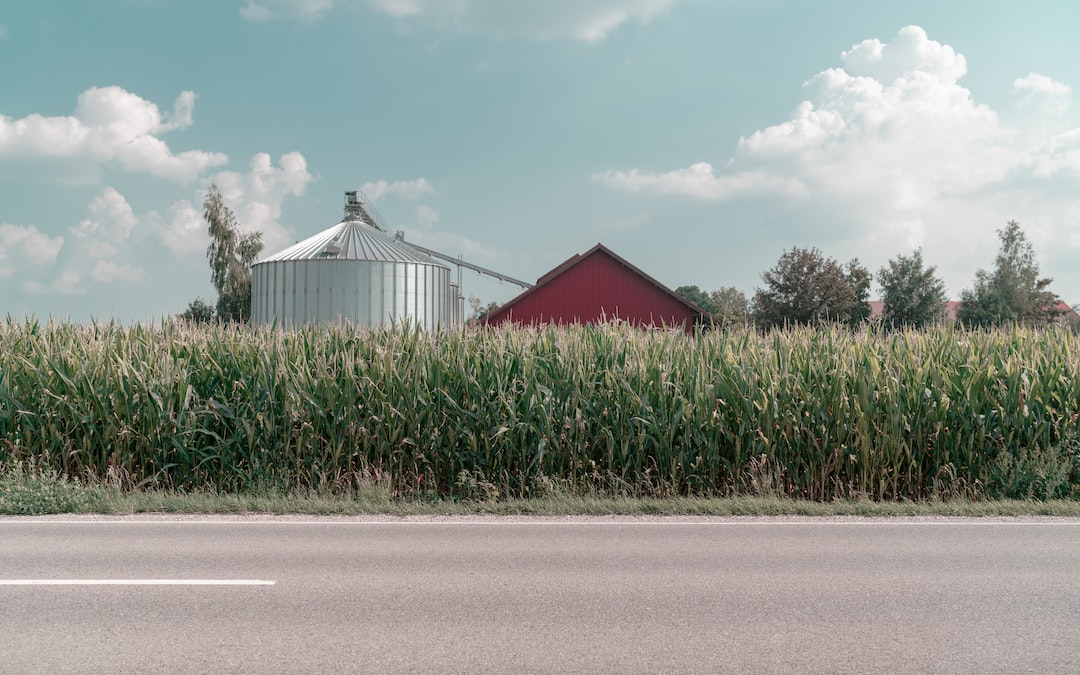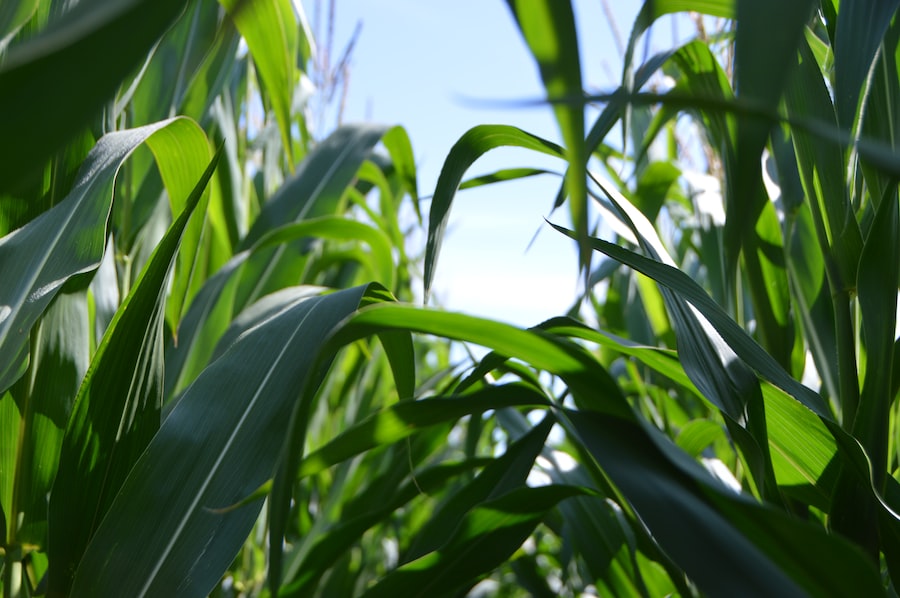Harvest Time: How to Tell When Your Corn is Ripe for Picking

Understanding the growth cycle of corn and the timing of harvesting is crucial for farmers and agricultural professionals. Corn is one of the most important crops worldwide, and its growth cycle plays a significant role in determining its maturity and quality. Harvesting corn at the right time ensures optimal yield and quality, which directly impacts the profitability of farmers. In this article, we will explore the different stages of corn’s growth cycle, the importance of timing in corn harvesting, and various methods to determine corn maturity.
Key Takeaways
- Corn growth cycle includes germination, vegetative growth, reproductive growth, and maturity.
- Timing is crucial in corn harvesting to ensure maximum yield and quality.
- Signs of maturity in corn cobs include brown silks, dried husks, and a dent at the top of the kernel.
- Checking for kernel development involves cutting open a cob and examining the size and shape of the kernels.
- The color of the corn husks can indicate maturity, with mature corn having brown or yellow husks.
Understanding Corn’s Growth Cycle
Corn goes through several stages of growth before it reaches maturity. These stages include germination, vegetative growth, reproductive growth, and maturity. During germination, the seed absorbs water and begins to sprout. The vegetative growth stage is characterized by the development of leaves and stems. The reproductive growth stage is when tassels and ears start to form. Finally, during the maturity stage, the corn kernels reach their full size and dry down.
Each stage of corn’s growth cycle is important in determining its maturity. For example, during the vegetative growth stage, the plant establishes a strong root system and develops leaves for photosynthesis. This stage is crucial for ensuring healthy plant growth and maximizing yield potential. The reproductive growth stage is when pollination occurs, and kernels begin to form on the cob. This stage is critical for determining the number of kernels per ear, which directly impacts yield.
The Importance of Timing in Corn Harvesting
Timing plays a crucial role in corn harvesting as it directly affects both quality and yield. Harvesting corn too early can result in immature kernels with low starch content, leading to lower quality feed or food products. On the other hand, delaying harvest can result in over-mature kernels that are prone to shattering or mold development.
Several factors need to be considered when deciding when to harvest corn. These include moisture content, kernel development, husk color, firmness of kernels, and the milk line method. Harvesting corn at the right moisture content is essential for proper storage and preventing spoilage. Fully developed kernels with a high starch content are desirable for both feed and food purposes. The color of the corn husks can indicate maturity, with brown or dry husks being a sign of readiness for harvest. Testing the firmness of kernels can help determine if they are mature enough for harvest. Lastly, the milk line method involves observing the color and position of the milk line on the kernels to determine ripeness.
Signs of Maturity in Corn Cobs
| Signs of Maturity | Description |
|---|---|
| Color | Yellow or brown kernels |
| Texture | Firm and hard kernels |
| Kernel spacing | Tightly packed kernels |
| Ear size | Full and plump ears |
| Husk cover | Tightly wrapped husks |
Identifying mature corn cobs is crucial for determining the right time to harvest. Mature corn cobs exhibit certain physical characteristics that indicate readiness for harvest. These include a full and plump appearance, with well-developed kernels that fill out the entire cob. The kernels should be tightly packed together and have a smooth texture. Immature cobs may have gaps between the kernels or uneven development, indicating that they are not yet ready for harvest.
It is important to identify mature corn cobs for harvesting to ensure optimal yield and quality. Harvesting immature cobs can result in lower yields and lower-quality kernels. Additionally, immature cobs may have a higher moisture content, making them more prone to spoilage during storage. By accurately identifying mature corn cobs, farmers can maximize their yield potential and ensure high-quality corn for various purposes.
How to Check for Kernel Development
Checking for kernel development is another important aspect of determining corn maturity. Fully developed kernels are essential for both yield and quality. To check for kernel development, select a few representative ears from different parts of the field. Gently peel back the husks to expose the kernels.
Fully developed kernels will be plump and fill out the entire cob. They should be tightly packed together without any gaps or spaces between them. The kernels should have a smooth texture and a bright, vibrant color. Immature kernels may appear smaller, have gaps between them, or have a wrinkled appearance. By checking for kernel development, farmers can ensure that their corn is mature and ready for harvest.
Observing the Color of the Corn Husks

The color of the corn husks can provide valuable information about corn maturity. As corn matures, the husks change color from green to brown or dry. Observing the color of the husks can help determine if the corn is ready for harvest.
Green husks indicate that the corn is still in the early stages of development and not yet mature. As the corn reaches maturity, the husks will start to turn brown or dry. This change in color indicates that the kernels have reached their full size and are ready for harvest. It is important to note that not all husks on an ear may change color at the same time. Therefore, it is essential to observe multiple ears and consider the overall trend in husk color to determine maturity.
Observing the color of the corn husks is an important method for determining when to harvest. Harvesting corn with green husks can result in immature kernels with low starch content, leading to lower quality and yield. By waiting until the husks have turned brown or dry, farmers can ensure that their corn is mature and ready for harvest.
Testing the Firmness of the Corn Kernels
The firmness of corn kernels is another indicator of maturity. Fully mature kernels should be firm and resistant to pressure. To test the firmness of corn kernels, gently squeeze a few kernels between your thumb and forefinger.
Mature kernels will feel firm and resist pressure, indicating that they are fully developed. Immature kernels, on the other hand, may feel soft or give way under pressure. Testing the firmness of corn kernels can help determine if they are mature enough for harvest. Firm kernels are desirable for both yield and quality, as they are less prone to damage during harvesting and storage.
Measuring the Moisture Content of the Corn
Measuring the moisture content of corn is crucial for proper storage and preventing spoilage. Harvesting corn with a high moisture content can lead to mold development and spoilage during storage. On the other hand, harvesting corn with a low moisture content can result in excessive dryness and loss of quality.
There are several methods to measure the moisture content of corn, including using a moisture meter or drying the corn in an oven. A moisture meter is a handheld device that measures the moisture content of corn kernels. It provides an accurate reading within seconds, allowing farmers to determine if the corn is at the desired moisture level for harvest.
Proper moisture content for corn storage varies depending on the intended use. For grain corn, a moisture content of around 15% is ideal for long-term storage. For silage corn, a moisture content of around 65-70% is optimal for fermentation and preservation.
Using the Milk Line Method to Determine Ripeness
The milk line method is another technique used to determine corn ripeness. The milk line refers to a visible line on the kernels that indicates the stage of maturity. To use this method, gently peel back the husks to expose the kernels. Look for a visible line on the kernels that separates a yellow or milky color from a white or starchy color.
The position of the milk line on the kernels can indicate ripeness. If the milk line is close to the top of the kernel, it indicates that the corn is still immature and not yet ready for harvest. As the corn matures, the milk line moves towards the bottom of the kernel. When the milk line reaches the bottom, it indicates that the corn is fully mature and ready for harvest.
Using the milk line method is a reliable way to determine corn ripeness and ensure accurate harvesting. By observing the position of the milk line on the kernels, farmers can determine if their corn is at the optimal stage of maturity for harvest.
Factors That Affect Corn Maturity
Several environmental and genetic factors can affect corn maturity. Understanding these factors is crucial for successful corn harvesting. Environmental factors include temperature, rainfall, and sunlight. Corn requires a certain amount of heat units or growing degree days (GDD) to reach maturity. The number of GDD required varies depending on the corn variety and the region.
Genetic factors also play a role in corn maturity. Different corn varieties have different maturity ratings, which indicate the number of days required for the corn to reach maturity. Farmers should select corn varieties that are well-suited to their region and have a maturity rating that aligns with their desired harvest window.
By understanding the environmental and genetic factors that affect corn maturity, farmers can make informed decisions about when to plant and when to harvest. This knowledge allows them to maximize yield potential and ensure high-quality corn.
Tips for Successful Corn Harvesting and Storage
To ensure successful corn harvesting and storage, here are some practical tips:
1. Monitor moisture content: Regularly check the moisture content of harvested corn using a moisture meter. Adjust drying or storage methods accordingly to prevent spoilage.
2. Harvest at the right time: Use a combination of methods, such as observing husk color, testing kernel firmness, and checking kernel development, to determine the optimal time for harvest.
3. Use proper harvesting equipment: Ensure that harvesting equipment is properly calibrated and adjusted to minimize damage to kernels during harvest.
4. Store corn in appropriate conditions: Store harvested corn in clean, dry bins or silos with proper ventilation to prevent mold development and spoilage.
5. Regularly monitor stored corn: Check stored corn regularly for signs of spoilage, such as mold growth or off odors. Take appropriate actions, such as drying or aerating, to maintain quality.
Proper harvesting and storage practices are essential for maintaining the quality and yield of corn. By following these tips, farmers can ensure successful corn production and maximize profitability.
Understanding the growth cycle of corn and the timing of harvesting is crucial for farmers and agricultural professionals. Harvesting corn at the right time ensures optimal yield and quality, which directly impacts profitability. By observing physical characteristics such as husk color, kernel development, and kernel firmness, farmers can accurately determine corn maturity. Additionally, measuring moisture content and using the milk line method provide further insights into corn ripeness. By considering environmental and genetic factors that affect corn maturity, farmers can make informed decisions about planting and harvesting. By following practical tips for successful harvesting and storage, farmers can ensure high-quality corn and maximize profitability.



